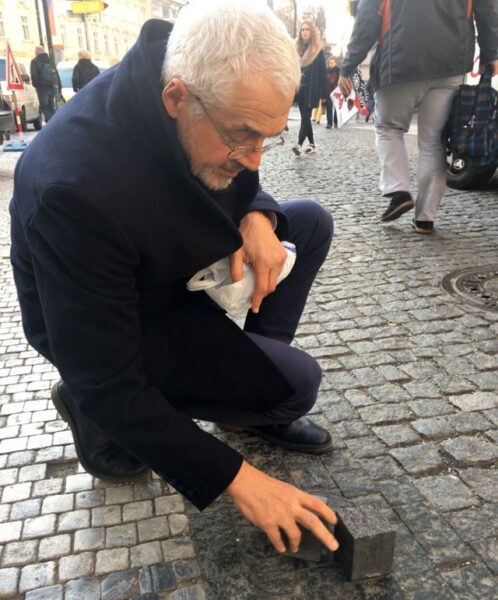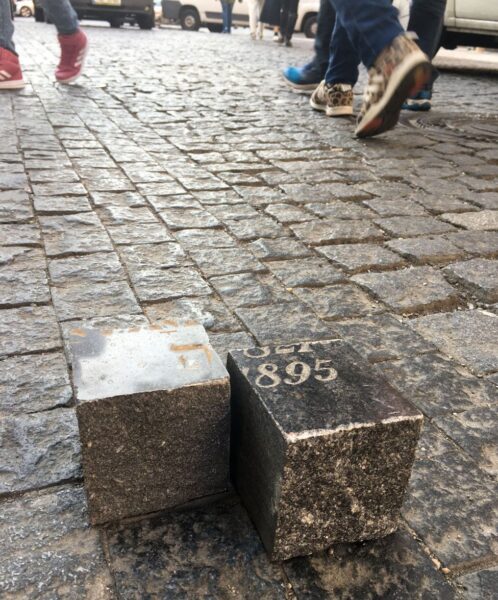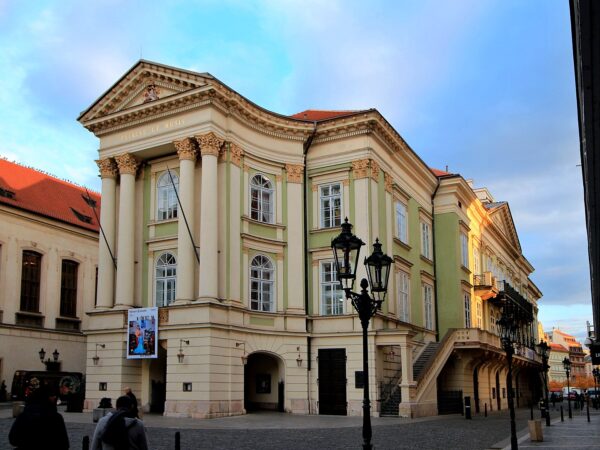While I’m mostly done with the Jewish Quarter and Jews in Prague, there’s one more item that arose in my research that I think you need to know about, before I proceed to the Estates Theater and the rest of my last day in Prague. In a word, it’s
Cobblestones.
The discovery begins in 1987 with Leo Pavlat who was, at one time, the director of the Jewish Museum in Prague. Mikhail Gorbachev was about to visit and the city government had new cobblestones laid at the bottom of Wenceslas Square in advance of his visit knowing he would have an official walk through that space. Pavlat was walking to work when something about a pile of cobbles caught his eye. Upon closer examination, he saw that the stones appeared to have been cut from Jewish tombstones. Seeing no one looking, he pocketed a few and continued on his way to work.

(From bbc.com)
“It wasn’t easy being Jewish back then,” he told the BBC in a 2019 interview. “There were no publications, no education. I think the regime just wanted the Jewish community to slowly die.”
And it had been dying. The combined weight of the Holocaust, outward emigration, and more than 40 years of communist rule had compressed the Jewish population in Czech lands from 350,000 before the Second World War to less than 10,000 in the late eighties when Pavlat found the stones. He eventually traced those stones to a Jewish cemetery established in 1864 in the town of Údlice in North Bohemia where Jews had established a community in the 17th century. Before the start of World War II, the Jewish population there had dropped to a mere 13. It’s likely that when the stones were removed from the cemetery in the 1980s no Jews remained. And Údlice was not unique in Czechoslovakia.

(From bbc.com)
Pavlat told the BBC, “I don’t think it was done deliberately by the Communists, to offend us Jews. But it is insensitive.” Still it needed more than 30 years and another improvement project for irrefutable confirmation that such stones had been widely used. New work on the lower section of Wenceslas Square unearthed nearly 6,000 cobblestones from Jewish graves with a total weight exceeding seven tons. The government returned them to the Jewish community.
In March 2022, the Jewish community in Prague received permission from the district of Prague 3 to construct a new memorial at the Old Jewish Cemetery, Žižkov (as differentiated from the Old Jewish Cemetery, Josefov). The memorial would be built under the Prague TV Tower that had appropriated a portion of that cemetery (as the Museum of Decorative Arts had with the Josefov cemetery nearly a century earlier) when its construction began in 1985.
One final note for visitors to Prague’s Jewish Quarter. If you have a guide or are merely observant of what’s beneath your feet, you will see these markers:

They have nothing to do with the cobblestones mentioned above. This is a Stumbling Stone or, in German, stolperstiene. Stolperstiene are the creation of the artist Gunter Demnig. Their intent is to “Remember the victims of National Socialism by installing commemorative brass plaques in the pavement in front of their last address of choice.” Plaques have been laid in Germany, Austria, Belgium, Croatia, the Czech Republic, Finland, France, Germany, Greece, Italy, Hungary, Lithuania, Luxembourg, Moldova, the Netherlands, Norway, Poland, Romania, Russia, Slovakia, Slovenia, Spain, Switzerland, and Ukraine.
The Estates
After lunch I had a choice. I could join Kathlene and other members of our group for a tour of the Estates Theater or try to squeeze in one or two more of the sites that populated my list of places to see in Prague. I opted for the former. Here’s why.
Certainly the Estates Theater has other aspects of historical importance but the reason for my choice is captured in this single sentence: On 29 October 1787, Mozart personally conducted the world premiere of Don Giovanni at the Estates Theatre. In some sense, I think I could quote from Keats and say this is “all ye need to know.” (In 1791 in honor of the coronation of Leopold II, the Estates also hosted the first public staging of Mozart’s final opera La Clemenza di Tito which he began after he completed most of his work on Die Zauberflöte [The Magic Flute].)
However, being me, I won’t stop with this. I’ll add that the Estates Theatre (Stavovské divadlo) opened in 1783 and is the oldest theater in Prague. It operated for 15 years under the name Nostitzsches Nationaltheater – for the man who financed it František Antonín Count Nostitz Rieneck – until it was purchased in 1798 by the Bohemian Estates. This is when it first acquired the name Theater of the Estates. Curiously, although it’s among the few neo-classical bulidings in Prague and though I walked by it on a number of occasions, I never took a photo. Here’s one from Wikimedia Commons.

(By VitVit – Own work, CC BY-SA 4.0)
For the next sixty plus years the Estates featured mainly German language plays and Italian Operas. Then in the 1860s, the Czech speaking people of Prague decided they should have a theatre devoted to Czech works. They opened the Provisional Theater in 1862 and the National Theater in 1881.
When the Czech troupe left in 1862, the theater became known as the Deutsches Landestheater (Provincial German Theatre) because it housed a solely German speaking company. It regained the name Theater of the Estates in 1920 when it affiliated with the National Theater. From 1948 until 1990 it was named to honor dramatist, writer, and actor J.K. Tyl whose poem Kde domov můj (Where My Home Is) provides the lyrics to the Czech National Anthem.
In the early 1980s, Miloš Forman used the theater as a location for a number of scenes for the film Amadeus using candles to create a touch of original realism – much to the consternation of the Czech authorities who likely spent many sleepless nights envisioning the building going up un flames. It was again named Theater of the Estates after the completion of a renovation project in 1990.
While I didn’t photograph the exterior, I did take a picture of this bronze marker on the stage

(At this place he accompanied and conducted on the harpsichord) and of this view of the stage

from the Emperor’s Box. It was here that our guide (I think her name was Marketa) sang us an acapella version of Czechia’s lyrically unique national anthem.
Dinner and a show
Our last night together ended with a full three course dinner at the Municipal House to be followed by a concert by the Czech Radio Philharmonic Orchestra in that building’s Smetana Hall. The meal was fine though not memorable enough for me to have made any comments in my nightly journal (or perhaps I was simply tired and anticipating my flight home). I did note the Art Nouveau style of the restaurant and the uninspired play of the local Piano Man who (probably fortunately) didn’t sing but did seem to have a rather broad repertoire ranging from ragtime to pop.
The concert that night featured a rather underappreciated piece – Les Éolides – by César Franck,
Beethoven’s Violin Concerto Op. 61
and the Concerto for Orchestra by Witold Lutosławski.
The hotel was essentially a straight line walk of about 250 meters from the Municipal House but as I was returning after the show, I happened upon Shlomit and Kathlene who were out for a walk in the direction of the Grand Café Orient and who unexpectedly invited me to join them – something I did happily.
I’ve nearly wrapped up my trip in the spring of 2022 and have two posts remaining. One will cover my trip home with a fun little addendum and will be quite brief. The final post will be the opposite as it recaps all the music references (I think) of this segment of the trip.
Meanwhile, here are the rest of the photos from my final full day in Prague.
Todd, you are brilliant. And clever. And endlessly generous with your sharing of experiences and knowledge. Thank you for each of these latest series of posts.
Thanks for reading Kathryn. I always appreciate comments and laudatory one even more so. 🥰